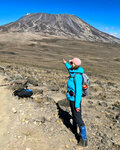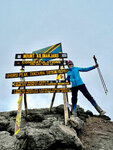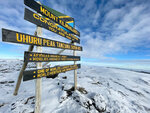




HAVE YOU EVER thought about doing something to challenge yourself physically and mentally or getting yourself out of your comfort zone? Well, I just did. I successfully hiked to the top of Mount Kilimanjaro (“Kili”).
My best friend, Lou, said to me, “You can do this… .” This became my mantra that propelled me forward, especially on that final push through to the summit.
I made the decision to climb Kili in 2019 and booked it with a plan for the upcoming year. The pandemic and the resulting postponements allowed me to research other people’s experiences climbing Kili. Many struggled and a significant percentage failed to summit.
Doing Kili is not a casual hike. I was reminded by this when I learned Tanzania requires everyone to have emergency evacuation insurance coverage! In addition, I chose a KPAP (Kilimanjaro Porters Assistance Project) partner trekking company staffed with trained “wilderness first responders.”
Choosing a trekking company with experienced guides and high summit success rates was important to me. My trek group included a head guide, assistant guide, chef and two waiters, three personal porters, 25 camp porters, and one porter who carried a full array of trauma gear. All were to support two other trekkers and me! I chose Thomson Safaris, headquartered in Watertown, Massachusetts. They seemed to be the best fit for me.
Seven main routes lead to the summit, and two descent routes. I chose the “Northern Circuit Route”. It’s the longest route, considered the least crowded, and giving me the best chance for altitude acclimatization. Being known as one of the most scenic routes was a draw for me since I intended to take lots of pictures!
My daily training routine focused on a combination of biking, power walking, and lifting free weights. I ramped up my conditioning six months before leaving by gradually adding up to 25 pounds of water in my infamous red backpack. Altitude training was certainly on my mind, yet appreciating I did not have the time (two weeks or more) necessary to acclimatize, I followed the guidelines the trekking company provided, such as walking slow (“pole, pole” in Swahili), drinking three-plus liters of water a day, eating a lot (not a time to diet), and taking Diamox (prescribed medication to help prevent altitude sickness). I can confidently say if you do follow these guidelines, you can significantly decrease many of the horrible side effects people shared in the many books I read.
Kilimanjaro is located in Tanzania, Africa. My climb first required flying for 22 hours, followed by a two-hour drive through the bush area to a secluded 11,000-acre game ranch where I would meet my trekking group.
Having been on an African game drive before, the experience on the ranch was great, but nothing could compare to the sunrises and sunsets I saw high up in the clouds on top of Kili.
From the ranch, it was a one-hour drive to Londorosi Gate.
I soon realized just how challenging the trail conditions were. Climbing up and over boulders above 11,000 feet required lots of energy! We started the hike in sunny temperatures above 70 degrees; it ended in pouring rain below 50 degrees. This turned out to be an omen for all the days ahead! I remember looking around the campsite wondering where the heck is Kili? Turns out I would not actually see Kili for the next two days since the trail would lead us down into deep valleys to help with altitude acclimatization.
I quickly appreciated the daily rhythm required for this hike. A cup of coffee and hot water would be delivered to my tent by 5 a.m. I had to be out of my tent by 6 a.m. along with my trekking poles, gaiters (keeps debris out of your boots), daypack and backpack filled with water bottles and multi-layers of clothes needed for the day. By the time we finished breakfast, the campsite was packed up, along with my duffle bag, and the porters were moving our gear to the next camp.
When we started hiking by 7:30 a.m., the temperature was typically 35-40 degrees. An hour later, the temperature could reach above 70 degrees in the sun. This would change each day, of course, as we reached higher elevations. I had to learn how to manage my clothing layers to fit the constantly changing conditions and was so happy that I followed the advice about what to pack.
Lunch was served outside on the trail. It amazed me the variety of soups, sandwiches, pasta, and fruit dishes the chef was able to prepare on the trail. Since we expended more energy as we climbed to higher altitudes, which increases your metabolism, it’s essential to eat lots of nutritious food and drink lots of water to avoid symptoms of altitude sickness.
We’d typically reach the next campsite by 2:30 p.m., and by that time, the temperature would be dropping. Seeing my tent already set up so I could collapse in my sleeping bag on my cot felt like a luxury! High tea with fresh ginger was at 4 p.m. with a bunch of snacks; my favorite was always popcorn! Dinner was at 6:30 p.m. By the time I got back to my tent, it was dark, so a solar light helped me organize and stuff whatever clothes I wanted to wear the next day in my sleeping bag.
I learned that sleeping with my clothes on was better than putting on frigid clothes in the morning! Included in our daily routine was measuring our pulse and oxygen levels every morning and night using an oximeter. This became a fun challenge to see who had the lowest pulse and highest oxygen level. Everyone wanted to beat me since I was the oldest! My higher-than-normal pulse rate throughout the hike probably reflected my doubts about summiting, despite the many reassurances from God-Love, our head guide!
Thankfully, none of us experienced any serious problems with our levels.
I was not expecting the hiking trails to be as difficult as they actually were. Interestingly, none of the books I read mentioned the trail conditions. Many hours were spent climbing over, down, around boulders and loose rubble of varying sizes. Some hugging and crawling became the safest way to get up and down! I kept thinking one accidental slip could end my hike to the top (not good!) The higher I climbed the more difficult it became since exerting a lot of energy makes you breathe even harder.
Hmmm…maybe I should have expected this climbing a volcanic mountain!
As we hiked and climbed each day, the scenery and weather were ever-changing, creating new picture-taking challenges and opportunities. Changes in vegetation became very noticeable while hiking through the heath, alpine and moorland areas. The grasses and succulent plants were all huge. Some familiar flowers such as heather, lobelia, everlastings, and lilies were seen yet all were much larger than the varieties grown in our area; I kept wondering how they can survive and thrive.
The first time I saw the Kili peak was at Moir base camp. We arrived in the rain, so it wasn’t until the next morning in the bright sunrise that Kili was there in all her glory. The sight was truly intimidating, and I wondered how the heck was I going to reach the summit, so I started to think of Kili as the “beast”.
What’s unique about the Northern Circuit route is being able to see Mawenzi, one of the three volcano peaks that make up Mount Kilimanjaro. At just under 17,000 feet, the jagged peaks make it more difficult to climb than Kili. Our base camp was located below at 14,200 feet. It rained soon after we arrived, then turned to sleet before the sun came out. The area just below Mawenzi ridge is known as the Alpine desert, an area consisting of mostly bare rock and ice. We hiked out of the valley to a ridge that allowed us to look across what’s called the “cradle.” This is a six-mile stretch of mostly flat land between the Mawenzi and Kili peaks. The “Beast Kili” was now in full view. Looking across, I could see a green speck and a white line going up the side of the volcano.
I asked God-Love if that was our trail going up Kili? He said yes; I think that contributed to my higher pulse number that night! After hiking for about six hours across the cradle, we reached that green speck…the “Outward Bound” camp.
I was grateful to have had a day to hike on mostly flat terrain since we were now at 15,450 feet.
Summit day arrived! Coffee was delivered early at 4 a.m. Breakfast was ready by 4:30 a.m., and we were on the trail by 5 a.m. It was cold, dark, and blustery. We needed to use our headlamps for the first time. Starting out it was just below 30 degrees, and I was told it was going to get colder as we hiked up to the summit.
Looking at the sunrise on the way up with Mawenzi in the background is a view I will always remember. After hiking for over six hours, we reached the crater edge, where we had to crawl up over the ridge. It took another hour to hike around the ridge to Gilman’s Point and then Stella Point.
A massive glacier was in full view across the other side of the crater. The last 700 feet to reach the summit was simply brutal. It was so steep and breathing in enough oxygen was so difficult that it felt like I was hardly moving. Reflecting on my mantra, I kept repeating to myself, “I can do this!” It helped.
It took nearly another hour for those last 700 feet to reach the summit. Our celebration was brief at the top since the lack of oxygen and the effect of that last grueling climb took its toll.
Emotionally, I know that I celebrated this deep inside of me… “Yes, I did this.”
I reached Africa’s highest point, Uhuru Peak, the Swahili word for “freedom.” I will never forget witnessing the arctic silence and the stunning sight of clouds blowing across, covering the glaciers, and then quickly exposing these massive ice walls. It’s disheartening to think that one day this peak may be free of all these glaciers.
We hiked back down to Gilman’s Point for lunch. I camped overnight in the crater along with God-Love, two porters, and a chef. The rest of the team descended to the next base camp. I couldn’t pass up the opportunity to sleep in the crater of Mount Kilimanjaro. We descended to 18,802 feet into the Ruesch crater. We reached the crater while the sun was out, so I was able to walk around the moonscape and get a closer look at one of the glaciers.
That night seemed endless; I don’t remember sleeping at all. Perhaps it was the excitement of having just reached the summit, but more likely, I was feeling one of the common effects of being at high altitude. We left by 4:30 a.m. and descended 8,500 feet to meet up with the rest of the team for breakfast.
We descended another 5,000 feet to the Mweka Millenium camp. After lunch, we all gathered at the center of the campsite for a farewell ceremony with all the porters and guides. The tipping ceremony, a Tanzanian tradition, began with all the porters singing and dancing to celebrate what we all accomplished together. It also gave my fellow trekkers and me the opportunity to thank them as well.
We became a trekking family with a common goal. I will always remember their kindness, non-stop encouraging words, and eagerness to help my fellow trekkers and me, and always with a smile. It was their experience, many of whom have summited over 100 times, and their abilities to carry our duffle bags, food, and water and set up our tents that helped to make this climb a memorable success.
In the end, all I can think of is deep gratitude to friends, family, and colleagues at Family Capital for all their support, everyone in Manchester who shouted encouraging words as they drove by me, and the many conversations I had with people who stopped me along the way while training with my red backpack!
This experience will always remain with me. I would encourage anyone looking for a challenge to take on Kili.
Deb Blanchard is a resident of Manchester. Email her at deb.blanchard @verizon.net.